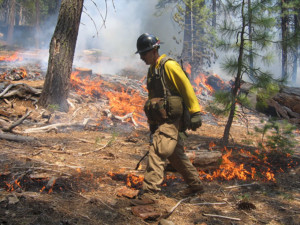
Summer 2017 ForestLife
Working with Fire
Pacific Forest Trust Helps Secure $10 Million for Managing Fire
 Wildfire is a part of life in California, but as we have seen increasingly over the past decade, our strategy of total suppression is not working. By trying to eliminate all fire, we have eliminated useful low-intensity burns while only the “unstoppable” fires escape, adding to more unhealthy forest conditions. Promoting new ways of working with fire for ecological and safety benefits is a key goal for Pacific Forest Trust (See President’s Letter, ForestLife 2016).
Wildfire is a part of life in California, but as we have seen increasingly over the past decade, our strategy of total suppression is not working. By trying to eliminate all fire, we have eliminated useful low-intensity burns while only the “unstoppable” fires escape, adding to more unhealthy forest conditions. Promoting new ways of working with fire for ecological and safety benefits is a key goal for Pacific Forest Trust (See President’s Letter, ForestLife 2016).
This year, Pacific Forest Trust led an effort to gain additional funding for CAL FIRE’s program to help rural forested communities prepare for wildfire. Our work resulted in an additional $10 million of State Responsibility Area funds in the state budget to support projects that directly benefit homes and communities located in or near California forests. The funds will help pay for fuel breaks near towns and the use of prescribed fire to restore forest resilience.
California does not have a “no fire” alternative
Historically, periodic fire was a natural part of the California landscape. Decades of suppression has interrupted that cycle of low-intensity fire and contributed to today’s unnaturally dense forests. Now, when fires do occur, they are often more intense and do more damage than the fires of the past.
California legislators, landowners, and agencies are starting to recognize the need to reintroduce fire into the landscape. Among the most forward-thinking is Chief Ken Pimlott, CAL FIRE director and California’s State Forester. Last year, CAL FIRE joined in the “Fire MOU,” a memorandum of understanding with more than 20 agencies, nonprofits, and stakeholder groups, including Pacific Forest Trust, to work together to promote the careful, increased use of fire.
“We need to double-down on increased community protection and education, at the same time recognizing that prescribed fire has a key role in reducing the intensity of these fires,” Pimlott said when the MOU was announced. “Returning more prescribed fire to the landscape can help renew ecosystems and assist landowners in reducing the accumulation of flammable vegetation.”
Pacific Forest Trust honored Director Pimlott for his work to restore ecological fire with the Outside the Box Award in 2017.
Toward a New Strategy: Klamath-Cascade Advisory Council
At a recent meeting, Pacific Forest Trust’s Klamath-Cascade Advisory Council took on this burning issue. The Council brings together landowners, managers, mill owners, wildlife and water experts, and representatives from nonprofits and government agencies to provide guidance on Pacific Forest Trust’s work in this key forest region.
While these groups don’t always agree on every issue, when it comes to fire, there is now a strong consensus that total suppression, as a goal or a policy, is not tenable.
The group discussed challenges to bringing fire back to the landscape including economic barriers, permitting, and potential liability concerns. They agreed that there is an ongoing need to educate decision-makers and the public about the effects fire suppression has had on California forests. They also identified potential opportunities to restore fire to the landscape such as cross-ownership partnerships, prescribed burn trainings, and data-driven air quality monitoring as well as the potential to license private prescribed burn managers.
More in this Issue of ForestLife
- President’s Letter: Healthy Forests, Healthy People
- Conserving a Working Forest on Black Butte’s Iconic Landscape
- CA Assembly Passes the CARBON Act
- Restoring Watersheds Key to California’s Future Water Supply
- Walter and Jeanne Sedgwick
- More Pacific Crest Trail Conserved
- Three Million Trees Planted at Goose Lake Working Forest
